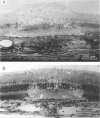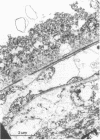Abstract
AIMS--This study was carried out to compare the effects of continuous wave infrared laser radiation on pigmented and albino rabbit retinas at two wavelengths: 810 nm (diode) and 1064 nm (Nd:YAG). METHODS--Transpupillary laser pulses were applied with a spot size of 200 microns and durations of 200 ms (pigmented rabbits) and 0.5-1 s (albino rabbits). Light and electron microscopic analyses were performed immediately after exposure. RESULTS--In pigmented rabbits, threshold lesions were induced using a power of 100 mW with the diode and 200 mW with the Nd:YAG lasers. Damage was incurred by the retinal pigment epithelium with extension into the superficial and mid choroid posteriorly and into the outer retina anteriorly. In albino rabbits, lesions of comparable anteroposterior extension were identified using a power of 10 W with the Nd:YAG laser. Using diode laser irradiation, a maximum power output of 1.2 W failed to produce discernible lesions. CONCLUSIONS--The observed patterns of morphological damage are produced by complex tissue radiation interactions. In pigmented animals, this was primarily related to absorption of radiant energy by melanin within the retinal pigment epithelium and the choroidal melanocytes. In albino rabbits, laser induced effects occurred as a consequence of multiple scattering, together with absorption within haemoglobin and possibly also within tissue water. The data obtained provide further insight into the biological mechanisms arising from retinal photocoagulation with near infrared lasers.
Full text
PDF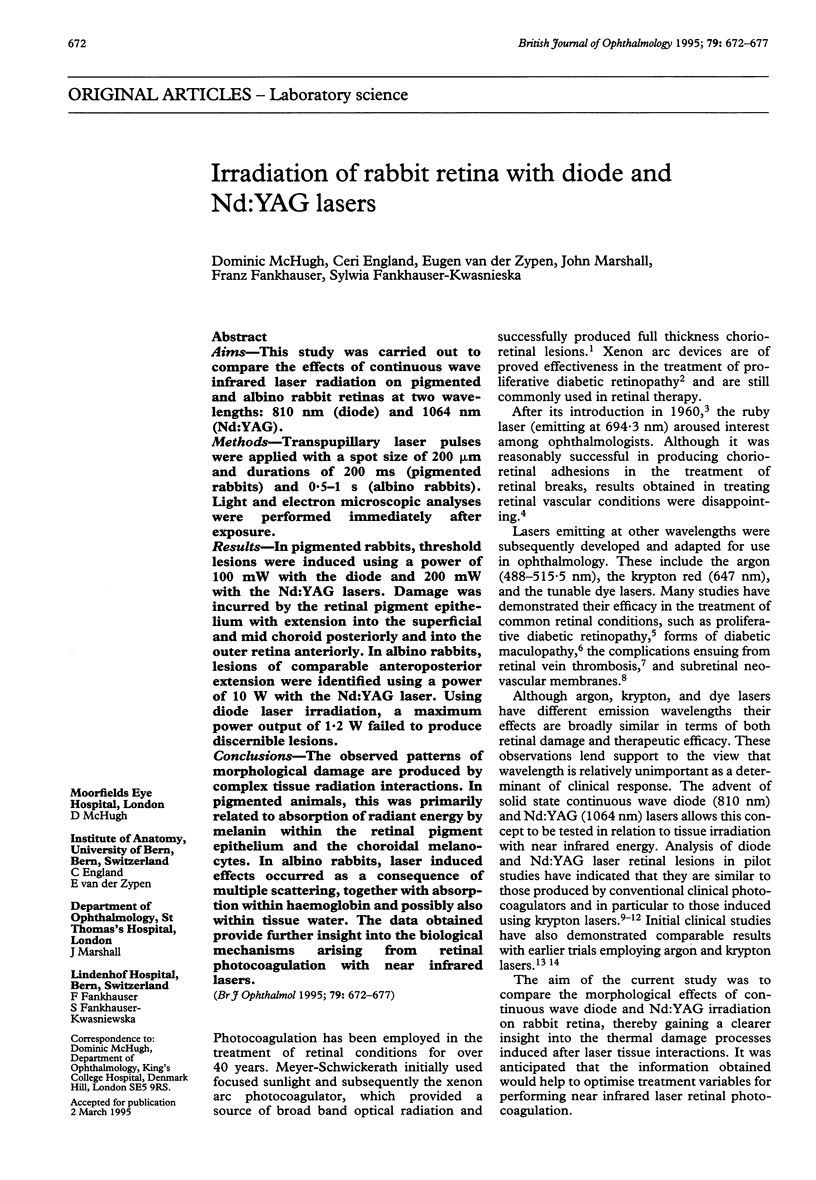
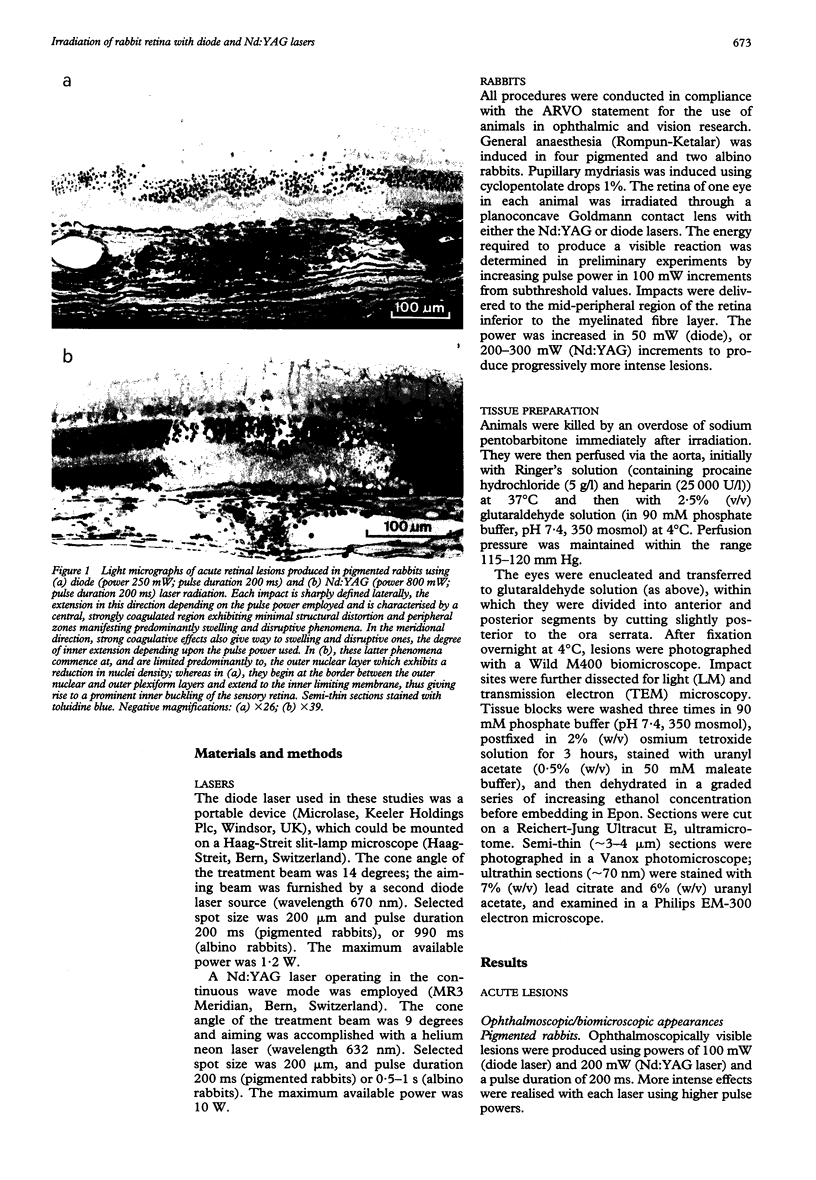
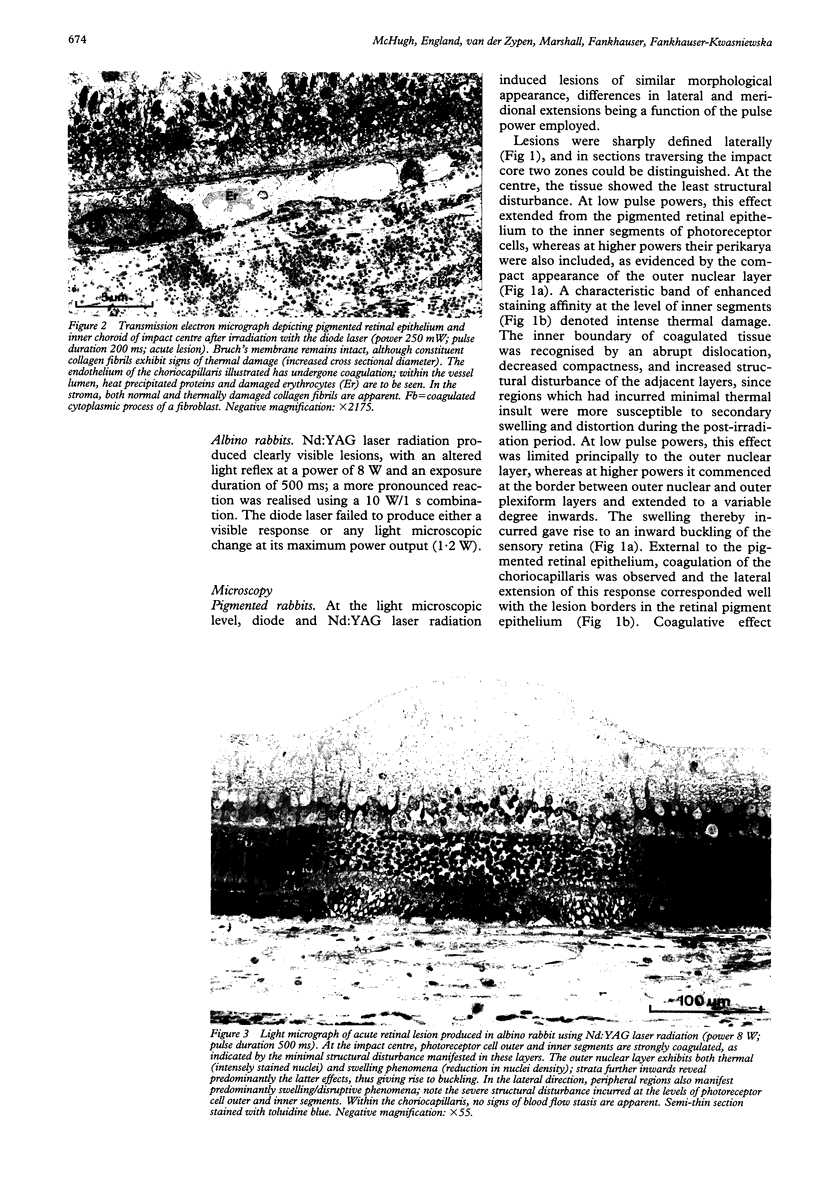
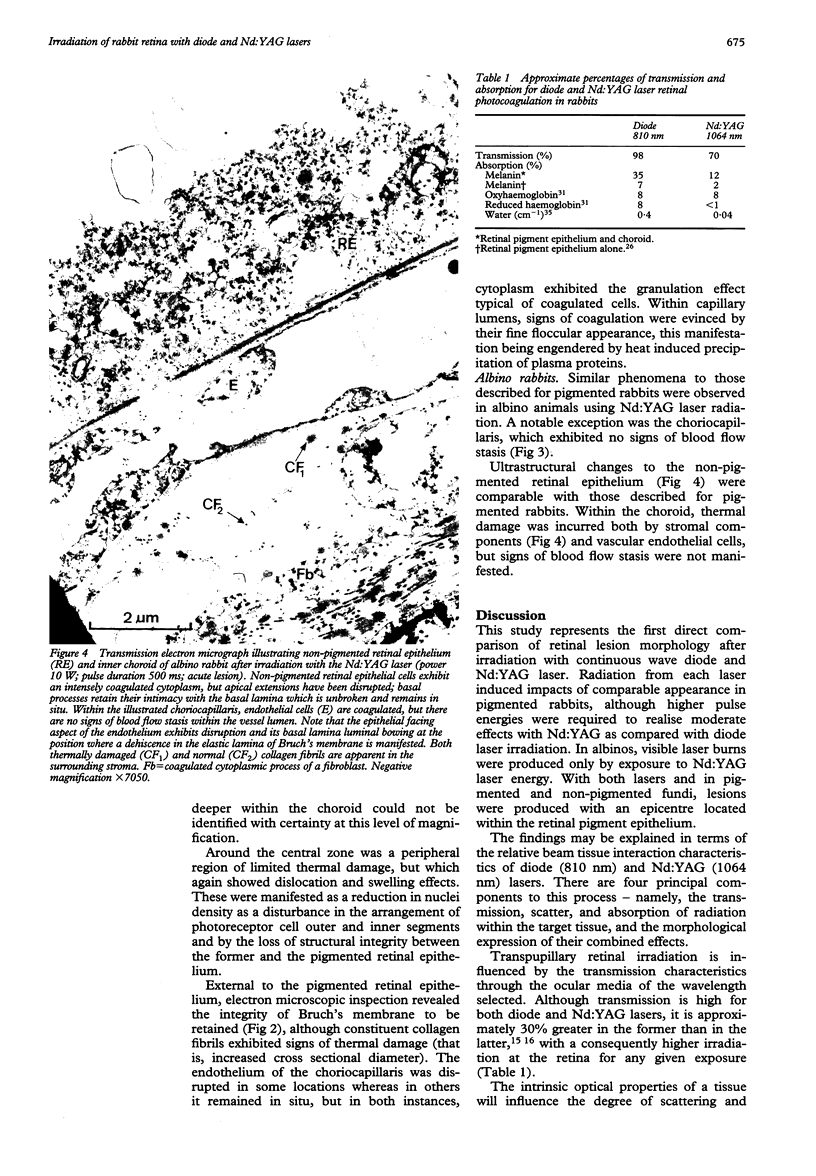
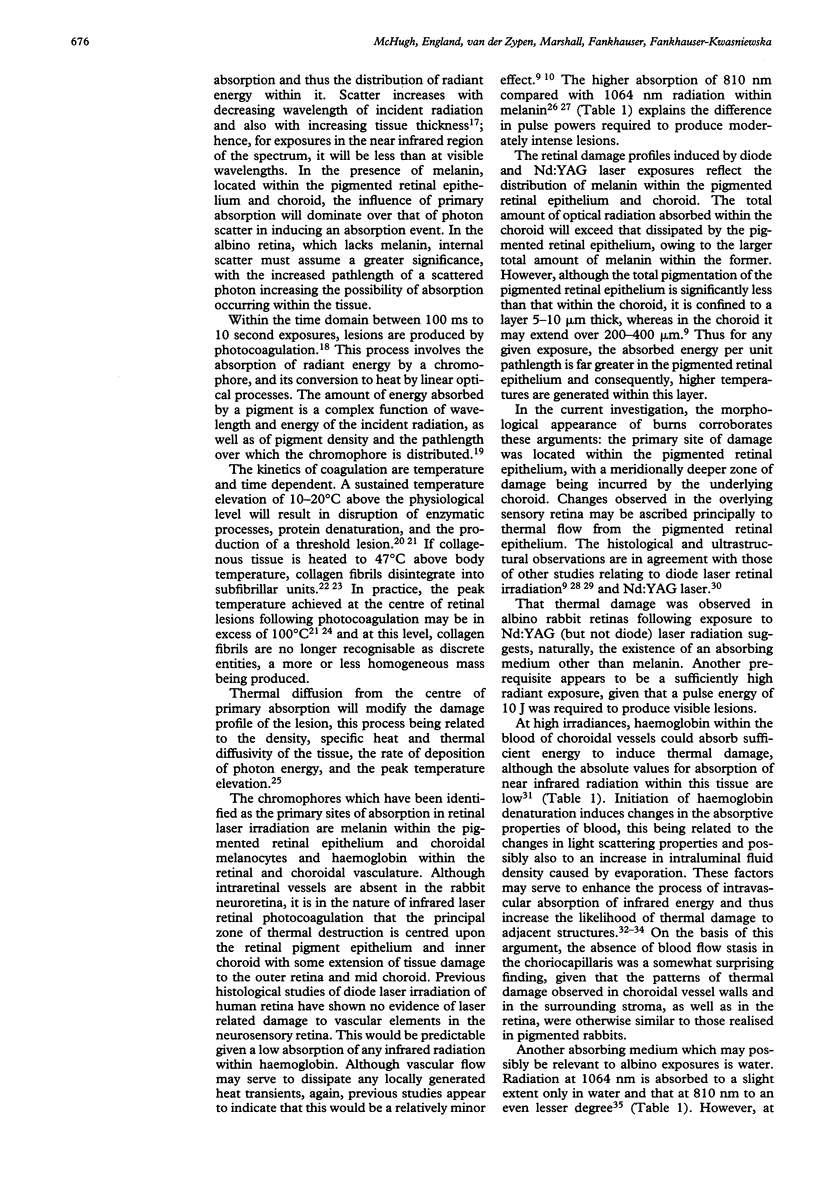
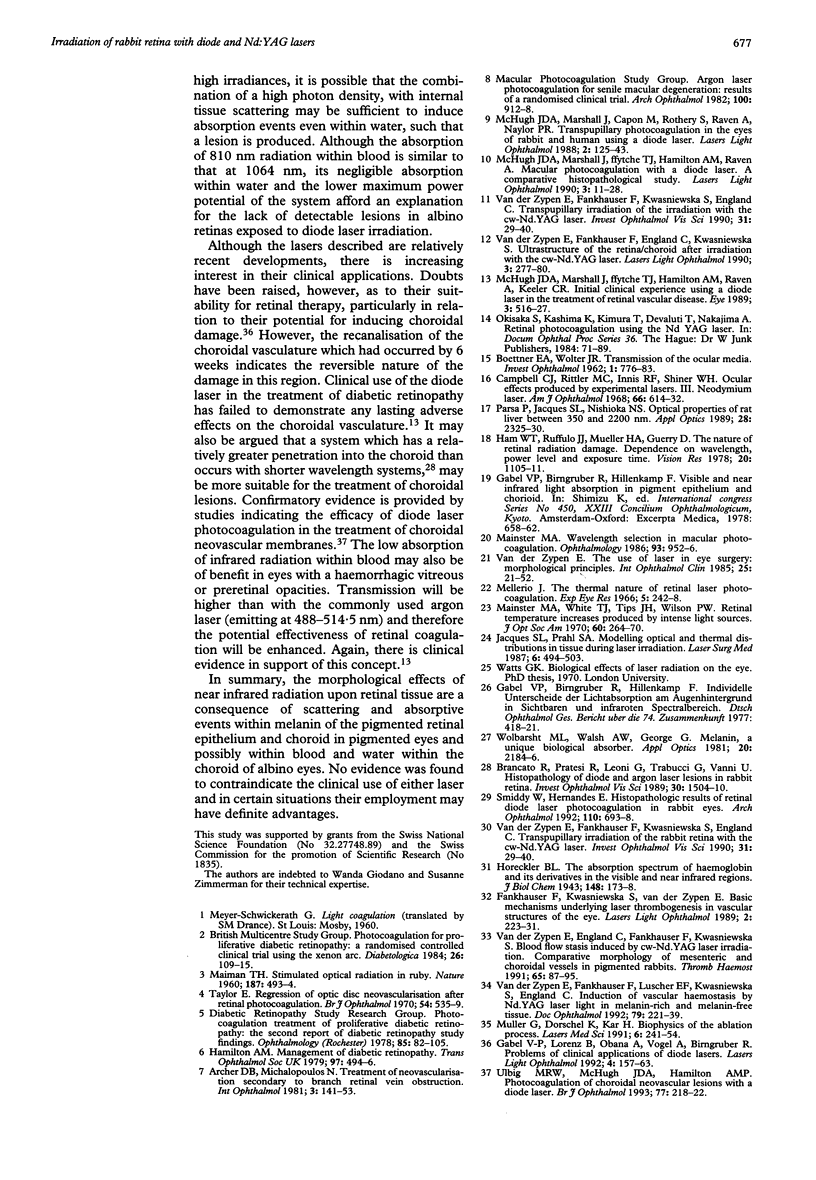
Images in this article
Selected References
These references are in PubMed. This may not be the complete list of references from this article.
- Archer D. B., Michalopoulos N. Treatment of neovascularization secondary to branch retinal vein obstruction. Int Ophthalmol. 1981 May;3(3):141–153. doi: 10.1007/BF00130697. [DOI] [PubMed] [Google Scholar]
- Brancato R., Pratesi R., Leoni G., Trabucchi G., Vanni U. Histopathology of diode and argon laser lesions in rabbit retina. A comparative study. Invest Ophthalmol Vis Sci. 1989 Jul;30(7):1504–1510. [PubMed] [Google Scholar]
- Campbell C. J., Rittler M. C., Innis R. E., Shiner W. H. Ocular effects produced by experimental lasers. 3. Neodymium laser. Am J Ophthalmol. 1968 Oct;66(4):614–632. doi: 10.1016/0002-9394(68)91281-6. [DOI] [PubMed] [Google Scholar]
- Gabel V. P., Birngruber R., Hillenkamp F. Individuelle Unterschiede der Lichtabsorption am Augenhintergrund im sichtbaren und infrarotin Spektralbereich. Ber Zusammenkunft Dtsch Ophthalmol Ges. 1977;74:418–421. [PubMed] [Google Scholar]
- Ham W. T., Jr, Ruffolo J. J., Jr, Mueller H. A., Guerry D., 3rd The nature of retinal radiation damage: dependence on wavelength, power level and exposure time. Vision Res. 1980;20(12):1105–1111. doi: 10.1016/0042-6989(80)90047-4. [DOI] [PubMed] [Google Scholar]
- Hamilton A. M. Management of diabetic retinopathy. Trans Ophthalmol Soc U K. 1977 Sep;97(4):494–496. [PubMed] [Google Scholar]
- Jacques S. L., Prahl S. A. Modeling optical and thermal distributions in tissue during laser irradiation. Lasers Surg Med. 1987;6(6):494–503. doi: 10.1002/lsm.1900060604. [DOI] [PubMed] [Google Scholar]
- Mainster M. A. Wavelength selection in macular photocoagulation. Tissue optics, thermal effects, and laser systems. Ophthalmology. 1986 Jul;93(7):952–958. doi: 10.1016/s0161-6420(86)33637-6. [DOI] [PubMed] [Google Scholar]
- Mainster M. A., White T. J., Tips J. H., Wilson P. W. Retinal-temperature increases produced by intense light sources. J Opt Soc Am. 1970 Feb;60(2):264–270. doi: 10.1364/josa.60.000264. [DOI] [PubMed] [Google Scholar]
- McHugh J. D., Marshall J., Ffytche T. J., Hamilton A. M., Raven A., Keeler C. R. Initial clinical experience using a diode laser in the treatment of retinal vascular disease. Eye (Lond) 1989;3(Pt 5):516–527. doi: 10.1038/eye.1989.83. [DOI] [PubMed] [Google Scholar]
- Mellerio J. The thermal nature of retinal laser photocoagulation. Exp Eye Res. 1966 Oct;5(4):242–248. doi: 10.1016/s0014-4835(66)80033-7. [DOI] [PubMed] [Google Scholar]
- Smiddy W. E., Hernandez E. Histopathologic results of retinal diode laser photocoagulation in rabbit eyes. Arch Ophthalmol. 1992 May;110(5):693–698. doi: 10.1001/archopht.1992.01080170115037. [DOI] [PubMed] [Google Scholar]
- Taylor E. Proliferative diabetic retinopathy. Regression of optic disc neovascularization after retinal photocoagulation. Br J Ophthalmol. 1970 Aug;54(8):535–539. doi: 10.1136/bjo.54.8.535. [DOI] [PMC free article] [PubMed] [Google Scholar]
- Ulbig M. W., McHugh D. A., Hamilton A. M. Photocoagulation of choroidal neovascular membranes with a diode laser. Br J Ophthalmol. 1993 Apr;77(4):218–221. doi: 10.1136/bjo.77.4.218. [DOI] [PMC free article] [PubMed] [Google Scholar]
- van der Zypen E., England C., Fankhauser F., Kwasniewska S. Blood flow stasis induced by cw-Nd:YAG laser irradiation: comparative morphology of mesenteric and choroidal vessels in pigmented rabbits. Thromb Haemost. 1991 Jan 23;65(1):87–95. [PubMed] [Google Scholar]
- van der Zypen E., Fankhauser F., Kwasniewska S., England C. Transpupillary irradiation of the rabbit retina with the cw-Nd:YAG laser. I. Acute morphologic effects produced using two different pulse forms. Invest Ophthalmol Vis Sci. 1990 Jan;31(1):29–40. [PubMed] [Google Scholar]
- van der Zypen E., Fankhauser F., Kwasniewska S., England C. Transpupillary irradiation of the rabbit retina with the cw-Nd:YAG laser. I. Acute morphologic effects produced using two different pulse forms. Invest Ophthalmol Vis Sci. 1990 Jan;31(1):29–40. [PubMed] [Google Scholar]
- van der Zypen E., Fankhauser F., Lüscher E. F., Kwansniewska S., England C. Induction of vascular haemostasis by Nd:YAG laser light in melanin-rich and melanin-free tissue. Doc Ophthalmol. 1992;79(3):221–239. doi: 10.1007/BF00158253. [DOI] [PubMed] [Google Scholar]
- van der Zypen E. The use of laser in eye surgery: morphological principles. Int Ophthalmol Clin. 1985 Fall;25(3):21–52. doi: 10.1097/00004397-198502530-00005. [DOI] [PubMed] [Google Scholar]



